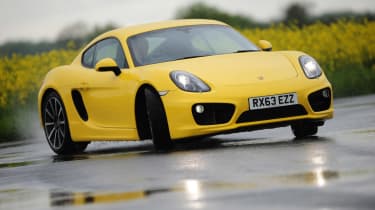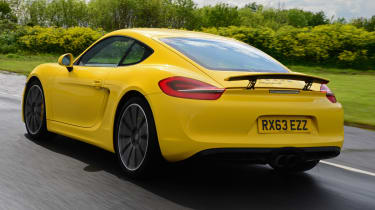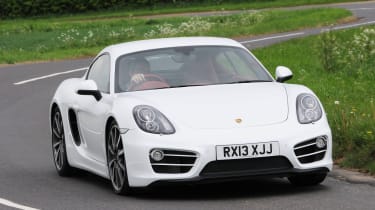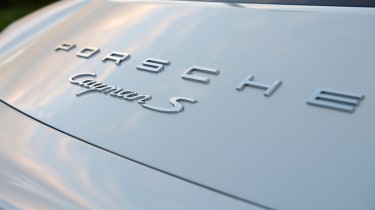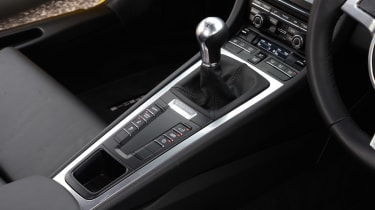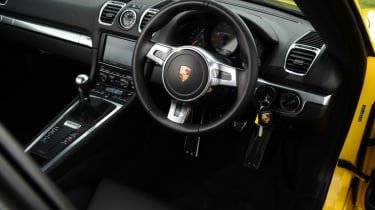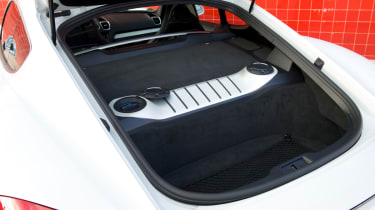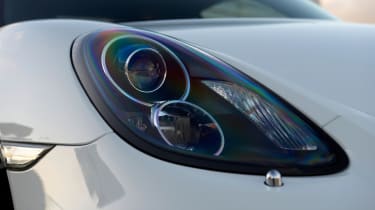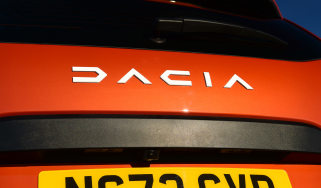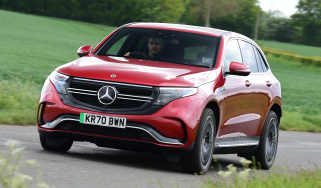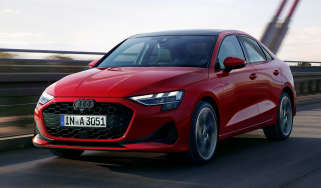Porsche Cayman review (2013-2016)
Porsche Cayman is the best sports car you can buy, with the awesome GT4 topping the range
When the second-generation Porsche Cayman was launched back in 2013, it followed the same formula as the 2006 original, but stepped out of the shadow of the larger Porsche 911. Smarter styling gave the Cayman its own identity, and the range is now more distinct than ever from the 911, as well as the Boxster roadster to which it is most closely related.
It’s still based on the two-seater Boxster platform, but this latest version of the Cayman has a wheelbase that’s 6cm longer than its predecessor’s; it’s just 3cm longer overall, though.
Power still comes from the flat-six (boxer) direct-injection engine, sited just forward of the rear axle, but the design has been successfully re-energised, with lowered suspension and more sculpted panels over the rear wheels.
The Cayman is built at the former Karmann factory in Osnabruck, Germany, alongside one of its VW Group stablemates, the Volkswagen Golf Cabriolet.
There are three models in the Cayman range: the entry-level car with a 2.7-litre flat-six engine, the 3.4-litre Cayman S, the Cayman GTS – which is based on the S but has an extra 15bhp and more standard kit – and the flagship Cayman GT4. The GT4 uses the bigger 3.8-litre engine from the old 911 Carrera S and 911 GT3 suspension parts. You’ll be lucky to get your hands on one, though, as the limited production run is already sold out.
More reviews
Car group tests
- BMW M2 vs Porsche 718 Cayman GTS: 2023 twin test review
- BMW M4 CSL vs Porsche 718 Cayman GT4 RS: 2022 twin test review
- BMW M240i Coupe vs Porsche 718 Cayman vs Audi TT RS: 2022 group test review
- BMW M2 CS vs Porsche 718 Cayman GTS vs Alpine A110 S
In-depth reviews
Long-term tests
Road tests
In November 2015, Porsche revealed a Cayman GT4 Clubsport at the LA Auto Show. It’s a race-orientated machine with only one seat and a roll cage, but rumours have been circulating about it paving the way for an even hotter roadgoing Cayman, badged GT4 R – so watch this space.
If you’re looking for a track-ready Cayman but don’t want anything as extreme as the GT4, all the other models come with the option of a Sports Chassis. This is 20mm lower than the basic suspension set-up, and makes the car perfect for track days.
It’s basically a Porsche Boxster with a roof, but the extra stiffness that roof gives to the chassis helps to make the Porsche Cayman a sublime sports car. In fact, it’s one of the finest-handling coupes money can buy.
The original Cayman was a true drivers’ car when it first appeared in 2006. This second-generation model is faster, but also lighter, which is great news for handling and fuel efficiency. It’s got more than enough performance for the road, but it’s also a reasonably practical two-seater that shouldn’t cost the earth to run.
• Porsche Cayman S vs Lotus Evora S
And when you want to exploit its potential, with the engine and all the major components positioned in between the two axles, the Cayman delivers perfect handling balance.
Engines, performance and drive
No company has as strong a reputation as Porsche for building driver-focused cars, and the Cayman is a great example of this. However, it isn’t an intimidating road racer, and if you don’t need more than two seats, the Cayman S could easily be a car you can use on a daily basis.
You’ll enjoy working the flat-six Porsche engine hard, especially with the optional sports exhaust, which delivers an evocative howl.
More importantly, the Cayman’s sublime chassis means you’ll never be left wanting by the driving experience. The car makes the most of its mid-engined layout and near-perfect weight distribution, so whether you’re on a track or the road, the Porsche’s brilliance shines through at every corner.
The chassis delivers bags of grip, body control is faultless and traction on the exit of tight corners is almost unbreakable. Plus, the steering is beautifully weighted, fast and accurate, and it’s easy to tighten your line or revel in the grip and balance of the Cayman.
Even without the brilliant optional PASM adaptive dampers, the ride is surprisingly supple, meaning the car soaks up and deals with bumps quite well. It’s refined, too, with not much in the way of wind and road noise.
The fast-shifting PDK twin-clutch automatic gearbox is well suited to the Cayman, allowing you to make the most of the car’s performance. And the sheer amount of grip available means the Porsche encourages you to push harder into every corner, while the steering is full of feedback so you can place the car exactly where you want. When you do reach the limit of grip on a track, the Cayman breaks away progressively, so you can catch slides easily.
Some people will prefer the slick-shifting six-speed manual gearbox. With a shorter throw and weightier action than before, it’s mechanically precise and integrates driver and car perfectly. It’s an old-school delight.
If you opt for the Cayman GT4, the suspension delivers huge grip and incredibly detailed feedback. It relays information back to you through each of the controls, giving you a little bit of extra confidence in the car's performance that you just don't quite get in the Cayman or Cayman S.
Regardless of which model you go for, on the open road, the Cayman consistently delivers a thrilling blend of performance, handling and driving pleasure at all times.
Engines
You’ll relish revving the engine all the way to the near-8,000rpm red line, which is just as well, as the 271bhp 2.7-litre Cayman needs to be worked hard. Power starts to build from 4,500rpm, when peak torque arrives, and with relatively long gearing, the car can seem a bit flat at low revs. Still, it’s fast enough, with 0-62mph taking 5.7 seconds and a top speed of 165mph.
The 321bhp 3.4-litre engine in the S model delivers more performance – it cuts the 0-62mph time to 5.0 seconds – while the uprated version provides 336bhp and a sprint time of 4.9 seconds in the GTS.
In 2015, Porsche revealed a new range-topper: the Cayman GT4. It uses the 380bhp 3.8-litre flat-six from the pre-facelift Porsche 911. This extra power helps the car cover 0-62mph in 4.4 seconds – two-tenths faster than a GTS with the PDK box, although the GT4 only comes with the six-speed manual – and it hits a top speed of 183mph.
MPG, CO2 and Running Costs
Considering the pure driving thrills it delivers, the Porsche Cayman doesn’t cost too much to own. Yes, it’s a relatively expensive indulgence, but the rewards an enthusiastic driver will earn from their investment are greater than for many more expensive supercars. When you factor in the Cayman’s practicality and usability, you could almost argue you’d be crazy not to buy one…
Fuel consumption is unlikely to be an issue for anyone considering a car like this, but is reasonable all the same. The smaller-capacity 2.7-litre engine in the standard Cayman claims 33.6mpg, but opt for the Cayman S and the official figure drops to 31.4mpg.
Porsche claims up to 34.4mpg with the PDK automatic gearbox, but even though it’s good, we couldn’t recommend it over the wonderful manual for pure driving pleasure – especially as the PDK will add around £2,000 to the purchase price.
Standard equipment includes xenon lights and air-con, but sat-nav, parking sensors and cruise control are optional extras that less premium brands wouldn’t have the nerve to charge you for. Even Bluetooth doesn’t feature, and there are plenty of other extras that will send the final price rocketing if you’re not careful.
Some of the more significant potential upgrades include: ceramic brakes (which will set you back around £5,000), a sports exhaust (£1,500), a torque vectoring differential (£900), plus active suspension and the sport chrono package (which cost around £1,000 each).
You can also add adaptive cruise control for about £1,400, a leather interior package for £3,000 or so, sat-nav for just over £2,000, mobile phone preparation for around £500… and the list goes on.
Insurance groups
The standard Cayman sits in insurance group 37, and as the performance increases across the range, so does the cost of cover. The Cayman S is in group 41, and the GTS in group 43. Topping the table, not surprisingly, is the Cayman GT4, which has a group 50 rating.
Depreciation
The Porsche Cayman fares pretty well on the depreciation front – certainly better than the Porsche 911 in percentage terms. Our experts predict that the car will retain somewhere between 50 and 55 per cent of its new price after three years and 60,000 miles, although that won’t be the case if you’ve spent a fortune on options.
Interior, design and technology
Porsche is famous for producing the legendary rear-engined 911, but it’s also tried its hand at building mid-engined cars, and the models that have followed this format have gone down in history as some of the most successful sports cars ever.
The Cayman is the latest road car to use this template, and as you would expect, it shares its styling cues with the Boxster roadster, albeit with the addition of a metal roof that incorporates a large glass tailgate, bringing extra practicality.
The low nose, round headlights and distinctive profile mean the Cayman is unmistakably a Porsche, while the entry-level 2.7 model can be upgraded to look just like more powerful versions, with bigger wheels and colour-coded trim.
Up front there are the familiar round lights and low nose, inspired by the larger 911, while the slab sides and hunched rear wheelarches are better suited to the Cayman’s coupe profile than that of the drop-top Boxster.
However, the Porsche has to play second fiddle to the Jaguar F-Type Coupe and Alfa Romeo 4C in the style stakes – it’s more reserved than the muscular F-Type and not quite as extrovert as the 4C, with its baby supercar shape.
Still, with the rear spoiler cutting neatly into the tail-lights, there’s beauty in the Cayman’s sharp detailing, too, while the optional 20-inch Carrera Classic wheels look fantastic. The GTS gets 20-inch alloys as standard, as well as slightly redesigned bumpers, unique badging and lashings of Alcantara and leather in the cabin.
The GT4 also benefits from bespoke alloys and a big bodykit – including a redesigned front bumper with a jutting splitter, and an aggressive rear wing – to reinforce its status at the top of the Cayman tree.
No matter whether it’s a luxurious S model or the stripped-out GT4, when you climb inside, the Cayman oozes quality. The layout has plenty of traditional Porsche touches, including overlapping dials on the dash, banks of buttons flanking the gearlever, as well as high-quality plastics and metal trim.
The layout takes a bit of getting used to, especially the rather vague climate controls, but there’s no faulting the driving position, while the clear view out and well weighted controls mean the Cayman is surprisingly easy to drive.
Sat-nav, stereo and infotainment
We’d argue that the sports exhaust is the best audio upgrade for the Cayman – it costs about £1,500 – but music lovers have options to improve on the standard four-speaker radio/CD system, which already comes with a seven-inch touchscreen.
The Bose surround-sound system will set you back around £800 and brings 10 speakers with 445 Watts of music, while the Burmester High-End system bumps the output up to 821 Watts from a total of 12 speakers, and includes a 300-Watt subwoofer.
Practicality, comfort and boot space
The driver and passenger sit low in the Cayman, yet despite the lack of standard parking sensors, low-speed manoeuvres around town are easy for a sports car like this, thanks to the good visibility.
Decent cabin refinement keeps the lid on road and wind noise, so the Porsche is also relaxing to drive out of town. The ride is surprisingly comfortable, too, unless you opt for the 20mm lower sports suspension. If you do, make sure you know what you’re letting yourself in for – the ride could easily become tiring on the daily commute. If you want to upgrade the suspension, the adjustable set-up probably makes more sense, unless you’re a track day regular.
For day-to-day practicality the Cayman scores highly, too. There’s plenty of storage, including a deep glovebox with a pair of twin cup-holders that pop out from the dashboard, as well as relatively large door bins.
Size
One of the reasons the Cayman is such fun to drive is that, unlike more exotic supercars, its compact dimensions ‘fit’ snugly around the driver, and it doesn’t seem to take up much room on the road.
It’s 4,380mm long by 1,801mm wide, and the width is the crucial measurement here; the Porsche is a whole 3cm slimmer than an Audi TT.
Leg room, head room & passenger space
As the Cayman doesn’t even attempt to offer rear seats, the two occupants have plenty of room. The driving position is excellent and highly adjustable, as we’ve come to expect from all German brands. However, drivers standing over six feet tall will need to be fairly supple to climb in.
While you don’t have the option of putting kids on a back seat, you can order optional ISOFIX child seat mountings for the passenger side.
Boot
As it’s a two-seater sports car, you wouldn’t expect the Porsche Cayman to be particularly practical. However, you might be surprised by how much luggage you can take with you. The tailgate lifts to reveal a shallow load area; Porsche claims that it has a volume of 275 litres.
The two deep bins either side of the engine cover are useful, although they are tricky to access. Pop the bonnet, and you get a well shaped 150-litre front boot, which is deep and rectangular.
Reliability and Safety
The Cayman shares its running gear and electrical systems with other models in the Porsche range, and as the company engineers its cars with performance in mind, it should prove able to stand up to the rigours of everyday life on the road – and more than a few appearances out on track, too.
While the original Cayman was built in Finland by Valmet Automotive, the current car is assembled by German coachbuilder Karmann, although production standards are as high as they are at the manufacturer’s own Stuttgart works.
If something does go wrong, at least you should have a relatively soothing experience when getting it fixed. The Porsche franchised network finished an impressive eighth out of 31 in the dealers chart of our Driver Power 2015 satisfaction survey – although this was five places down on its 2014 result. The Cayman itself was not rated in the individual Driver Power poll, but the car certainly has a durable feel.
There’s no independent crash test result to compare for the Cayman, although buyers have no reason to be concerned about the car’s safety credentials. In fact, Porsche reckons the latest models are 30 per cent stiffer than earlier versions, and all cars get six airbags around the cabin, as well as stability control.
Adaptive cruise control can be added to help improve safety on the motorway, and of course the Cayman’s terrific grip, traction and braking – as well as its agility – mean you’ve a greater chance of avoiding trouble in the first place.
Warranty
In line with premium rivals such as Aston Martin, Jaguar and Mercedes, Porsche offers a three-year/unlimited-mileage warranty across its model range. And of course, you can extend the cover at extra cost.
Servicing
Porsche is confident that its cars will last, so the Cayman has two-year service intervals. But while wear-and-tear items will be expensive to replace – and such components may be short-lived if you indulge in high-performance driving or track days – you can expect first-class service at the company’s dealers. Scheduled maintenance is pricey as well; the first three check-ups will set you back a total of £1,570.
Which Is Best
Cheapest
- Name2.0 2dr
- Gearbox typeManual
- Price£51,800
Most Economical
- Name2.0 2dr PDK
- Gearbox typeSemi-auto
- Price£53,999
Fastest
- Name4.0 GT4 RS 2dr PDK
- Gearbox typeSemi-auto
- Price£123,000
